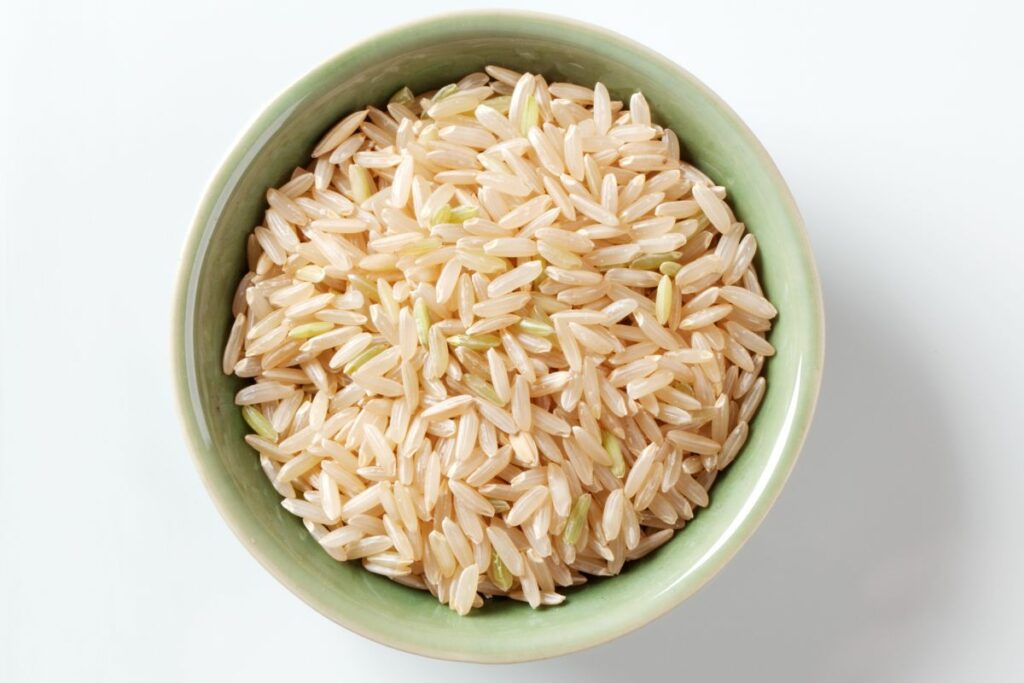Most people are aware of the fact that brown rice is healthier – or, at least, better for you – than white rice. But, what are the benefits of eating brown rice? Are there any disadvantages to eating it?
In this article, we will discuss the pros and cons of eating brown rice. Here is all you need to know about this whole grain food.
The Differences Between Brown Rice And White Rice
Before we jump into the advantages and disadvantages of consuming brown rice, you may be wondering, first off, what the differences are between brown rice and white rice.
White rice is generally more popular than brown rice, but is it better for you? Is brown rice better for you, health-wise, than brown rice? Let’s find out together.
White rice is consequently far lower in fiber and nutrients than brown rice. However, in contrast to brown rice, white rice has an extended shelf life as a result. White rice has a shelf life of around 10 years, while brown rice will only last roughly 6 months.
Anyone who has tried the two types of rice will know that there is a clear, distinct difference in flavor between the two. Brown rice has a nuttier, milder taste, while white rice barely has a flavor at all, unless it has been cooked with other ingredients.
Brown rice also has a chewier texture compared to white rice, which is very soft when boiled and cooked.
Compared to white rice, brown rice contains twice as much manganese, twice as much phosphorus, 2.5 times more iron, three times as much vitamin B3, four times as much vitamin B1, and ten times as much vitamin B6. Therefore, it is a lot better for you.
So, while white rice may be cheaper to buy, and easier to find on store shelves, brown rice is probably the better option to go for, in terms of flavor, texture, and nutritional value.
The Advantages Of Brown Rice
Now that you are aware of why brown rice is better for you than white rice, let’s take a look at all the benefits that you may reap from consuming some brown rice.
The Nutritional Value Of Brown Rice
As we mentioned earlier, brown rice is a lot healthier than white rice, and contains fewer calories. It is also filled with manganese, phosphorus, iron, vitamin B3, vitamin B1, vitamin B6, and fiber.
Brown rice will contain 111 calories per 100 grams. Only 0.9 grams of fat, including 0.2 grams of saturated fat, 0.3 grams of polyunsaturated fat, and 0.3 grams of monounsaturated fat, makes up the entire serving. Furthermore, it doesn’t contain any cholesterol.
Brown Rice Is Packed With Antioxidants
Brown rice has a far higher level of antioxidants than white rice. Antioxidants are crucial because they work to combat the free radicals already in your body, freeing up your body’s natural defenses to handle bigger problems.
Additionally, antioxidants are known to fend off some forms of cancer, and even aid in keeping your cells from oxidizing when energy is generated in your body.
Brown Rice Helps With Weight Gain

Brown rice is much superior for people who want to maintain their weight loss, even if white rice can be beneficial in moderation. It can assist you in lowering your BMI since it is high in manganese, which is beneficial for synthesizing body fat.
Additionally, brown rice has potent anti-obesity properties and helps increase the amount of healthy HDL cholesterol in your body.
Brown Rice Prevents Alzheimer’s
Gamma-aminobutrynic acid, which is abundant in brown rice and aids in the prevention of numerous neurological illnesses. It benefits by preventing the damaging enzyme protylendopetidase from functioning.
In fact, there is an explicit relationship between this specific enzyme and Alzheimer’s disease. As a result, eating brown rice may reduce your risk of developing it yourself.
Brown Rice Helps Digestion
As we’ve already established, brown rice is a good source of fiber, which thickens stools and moves them along the gastrointestinal system. This is crucial because it enables people to have regular and healthy bowel movements.
Additionally, brown rice has an additional bran layer on the exterior that prevents an excessive absorption of acid. The texture retention throughout digestion is substantially improved as an outcome.
Brown Rice Helps Insomnia
While medication and therapy can occasionally be used to treat insomnia, there are also a few natural treatments that can be used in its place. Surprisingly, brown rice is one of them.
Due to its high melatonin content, which is a hormone that promotes sleep, brown rice is an effective treatment for insomnia. It can treat all insomnia-related issues by regulating your sleep cycle and ensuring a deep slumber once you do fall asleep.
Brown Rice Helps To Fight Depression
Interestingly, brown rice can actually have an antidepressant effect on its consumer. This is due to the abundance of crucial nutrients present in germinated brown rice, including glutamate, glycerine, and GABA.
These neurotransmitters block brain signals connected to anxiety, tension, stress, and depressive states. As a result, when taken, they support a feeling of fulfillment and joy.
The Disadvantages Of Brown Rice
After reading the previous section, you may be wondering why more people don’t opt for batch-buying brown rice to consume during every meal of the day. There are so many advantages that most people don’t even know about!
However, where there are advantages, there are often disadvantages to follow. Here are some of the disadvantages of eating brown rice.
Brown Rice Causes Blood Sugar To Spike
Being a starchy food, brown rice poses a risk to those who must monitor their blood sugar when consumed in large quantities. This includes those with diabetes.
A single serving of cooked brown rice will have nearly the same percentage of carbohydrates as cooked white rice, notwithstanding the differences in nutrition and calories. Therefore, it should be consumed in moderation to prevent a spike in blood sugar.
Brown Rice May Contain Arsenic
Research suggests that brown rice contains fine traces of arsenic. This poisonous substance has been related to cardiovascular disorders, diabetes, and even cancer.
Although it occurs naturally in the natural world, some foods may contain higher concentrations of it.
Studies comparing the levels of arsenic in different types of rice revealed that brown rice contained higher inorganic arsenic than white rice.
Brown Rice May Cause Digestive Issues To Those With Sensitive Tummies
Although some people’s gastrointestinal systems benefit greatly from brown rice, those who are fiber-sensitive may experience negative effects. This includes people who suffer from inflammatory bowel diseases, including Crohn’s and colitis.
Both brown and white rice can be constraining, especially if you have a sensitive digestive system and/or frequently experience constipation. As a result, if you have a sensitive stomach, this food may set off an attack.
Final Thoughts
Overall, brown rice is a very nutritious food substance that is suitable for all people to eat. It can help fight against diseases and mental health issues, as well as supplying you with plenty of nutrients and vitamins.
However, if you suffer from irritable bowel diseases or diabetes, you may want to eat this food sparsely, as too much brown rice can cause health issues if eaten in abundance.
We hope you found this guide helpful.








